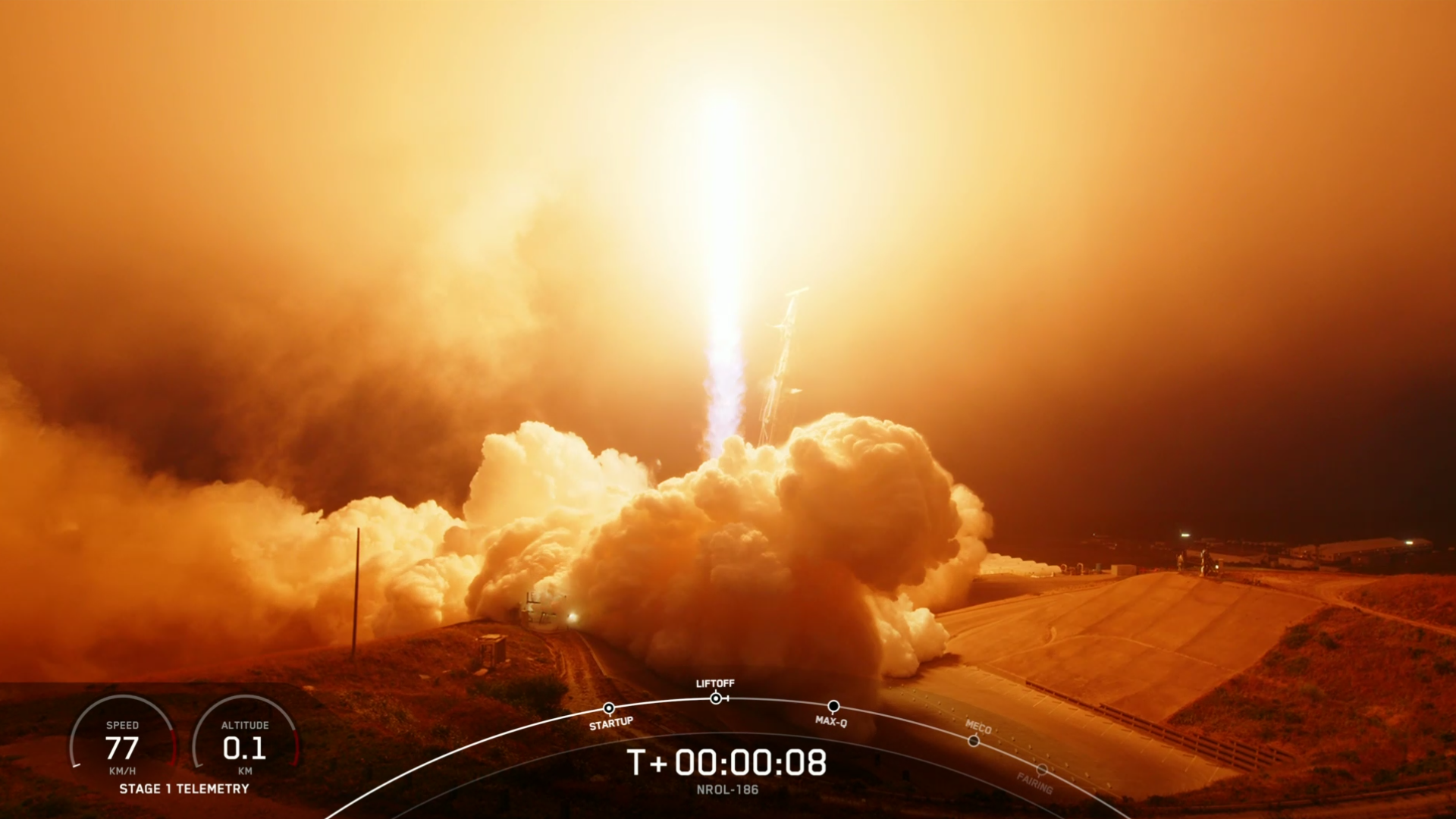

An eight-times-used Falcon 9 booster lifted off from Vandenberg Space Force Base, California, last night, carrying what is believed to be the second of up to six full batches of Starshield military satellites for the U.S. Intelligence Community. Cloaked under the mission name NROL-186, a National Reconnaissance Office designator, the mission lifted off from Space Launch Complex (SLC)-4E at the mountain-ringed West Coast launch site at 8:14 p.m. PDT Friday, marking SpaceX’s 67th flight of the year and its Juneteenth.
Derived from SpaceX's Starlink network of low-orbit Internet communications satellites, nearly 6,700 of which have been deployed across 179 Falcon 9 launches. between May 2019 and last weekStarshield is described as a constellation built specifically to deliver “disruptive” new military space capabilities to the governments of the United States and its allies. Built on the Starlink infrastructure, the joint SpaceX/Northrop Grumman Corp. program, for which the US government awarded contracts worth $1.8 billion in 2021, also includes additional target tracking, optical and radio reconnaissance capabilities. and missile early warning for customers such as the Space Development Agency (SDA), the United States Space Force and the NRO.
At least 12 Starshield satellite prototypes are believed to have flown as “rideshare” payloads on as many as five Falcon 9 missions. Since December 2020Two test satellites were also aboard a Vandenberg flight. Last Marchreportedly deployed in a 325-mile (525-kilometer) orbit, inclined 53.05 degrees to the equator.
The first “full” batch of 20 Starshield satellites launched last month from Vandenberg, under the NRO mission descriptor of “NROL-146,” and last night’s flight marked the second of up to six batches. These satellites are believed to have been placed into orbits with an average altitude of 310 kilometers (190 miles), with an inclination of 69.7 degrees.
SpaceX announced Thursday that it was considering two opportunities to launch this second Starshield mission, designated NROL-186: a first at 8:14 p.m. PDT Friday and a backup opportunity at 8 p.m. PDT Saturday. It was the 22nd Falcon 9 launch from Vandenberg so far in the first half of 2024, an impressive cadence that saw SpaceX fly four times from the West Coast in a single schedule. for the first time in Januarybefore concluding its first month of five releases in May.
Last night's flight mission was a reinforcement. which entered service last August as a member of SpaceX’s East Coast fleet. B1081 launched four times from Florida, most recently in February, before being trucked west to become the sixth Falcon 9 core in active operational service at Vandenberg.
It was first used to carry Dragon Endurance and its Crew-7 quartet, consisting of NASA astronaut Jasmin Moghbeli, Denmark's Andreas Mogensen of the European Space Agency (ESA), Satoshi Furukawa of the Japan Aerospace Exploration Agency (JAXA), and Russian cosmonaut Konstantin Borisov. for their 6.5-month increment on Expedition 69/70 on the International Space Station (ISS)Two additional launches lasted November and December delivered the CRS-29 Cargo Dragon of SpaceX for a one-month research stay at the station and a batch of Starlink satellites. And in February Launched NASA's $805 million Plankton, Aerosol, Cloud, Ocean Ecosystem (PACE) mission perform critical measurements of our planet's oceans, atmosphere and climate on a global scale.
B1081 then moved west in February for the next phase of its career. Since the beginning of MarchIt has now flown four more times, deploying the 53-payload Transporter-10 rideshare payload, a Starlink batch of 21 satellites, the European Space Agency’s (ESA) EarthCARE mission to better understand the role of clouds and aerosols in reflecting incident solar radiation back into space, and last night’s flight of NROL-186.
In a not unexpected move, SpaceX provided few details about the flight's milestones beyond the successful landing of B1081 on the deck of the West Coast-based Autonomous Spaceport Unmanned Ship (ASDS), “Of course I still love you.” ”. The mission is believed to have included a couple of customary “burns” by the Falcon 9's single Merlin 1D+ second stage vacuum engine: a six-minute primary burn, followed by a coast period in orbit, then a brief second . burning for a few seconds, before the deployment of NROL-186.
Last night’s mission marks SpaceX’s 10th launch of June, a month that has seen seven Starlink batches and more than 150 discrete payloads launch, including the powerful Astra 1P geostationary communications satellite for Luxembourg-based SES and last week’s triumphant return of the three-barreled Falcon Heavy carrying the GOES-U weather and environmental monitoring sentinel, the fourth and final member of the National Oceanic and Atmospheric Administration’s (NOAA) Geostationary Operational Environmental Satellite (GOES)-R network.